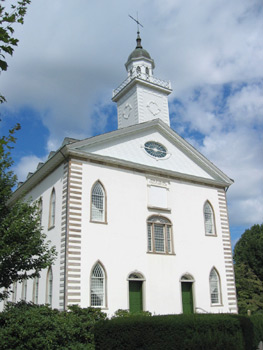Related Research Articles

In Mormonism, the endowment is a two-part ordinance (ceremony) designed for participants to become kings, queens, priests, and priestesses in the afterlife. As part of the first ceremony, participants take part in a scripted reenactment of the Biblical creation and fall of Adam and Eve. The ceremony includes a symbolic washing and anointing, and receipt of a "new name" which they are not to reveal to others except at a certain part in the ceremony, and the receipt of the temple garment, which Mormons then are expected to wear under their clothing day and night throughout their life. Participants are taught symbolic gestures and passwords considered necessary to pass by angels guarding the way to heaven, and are instructed not to reveal them to others. As practiced today in the Church of Jesus Christ of Latter-day Saints, the endowment also consists of a series of covenants that participants make, such as a covenant of consecration to the LDS Church. All LDS Church members who choose to serve as missionaries or participate in a celestial marriage in a temple must first complete the first endowment ceremony.

In the Latter Day Saint movement, the term ordinance is used to refer to sacred rites and ceremonies that have spiritual and symbolic meanings and act as a means of conveying divine grace. Ordinances are physical acts which signify or symbolize an underlying spiritual act; for some ordinances, the spiritual act is the finalization of a covenant between the ordinance recipient and God.

The Latter Day Saint movement is a religious movement within Christianity that arose during the Second Great Awakening in the early 19th century and that led to the set of doctrines, practices, and cultures called Mormonism, and to the existence of numerous Latter Day Saint churches. Its history is characterized by intense controversy and persecution in reaction to some of the movement's doctrines and practices and their relationship to mainstream Christianity. The purpose of this article is to give an overview of the different groups, beliefs, and denominations that began with the influence of Joseph Smith.

Washing and anointing is a ritual purification ordinance similar to chrismation that is part of the temple endowment ceremony practiced by The Church of Jesus Christ of Latter-day Saints and Mormon fundamentalists.

The Conference Center, in Salt Lake City, Utah, is the premier meeting hall for the Church of Jesus Christ of Latter-day Saints. Completed in 2000, the 21,000-seat Conference Center replaced the traditional use of the nearby Salt Lake Tabernacle, built in 1868, for the church's biannual general conference and other major gatherings, devotionals, and events. It is believed to be the largest theater-style auditorium ever built.
Fast Sunday is a Sunday set aside by the Church of Jesus Christ of Latter-day Saints for fasting by its members. On Fast Sunday, a fast and testimony meeting is held by local congregations of the Church of Jesus Christ of Latter-day Saints.

The Kirtland Temple is a National Historic Landmark in Kirtland, Ohio, United States, on the eastern edge of the Cleveland metropolitan area. Owned and operated by the Community of Christ, formerly the Reorganized Church of Jesus Christ of Latter Day Saints (RLDS), the house of worship was the first temple to be built by adherents of the Latter Day Saint movement. The design mixes the Federal, Greek Revival, and Gothic Revival architectural styles.
"The Spirit of God Like a Fire Is Burning" is a hymn of the Latter Day Saint movement. It was written by W. W. Phelps, one of the most prolific hymnwriters of early Mormonism.

In the Latter Day Saint movement, a temple is a building dedicated to be a house of God and is reserved for special forms of worship. A temple differs from a church meetinghouse, which is used for weekly worship services. Temples have been a significant part of the Latter Day Saint movement since early in its inception. Today, temples are operated by several Latter Day Saint denominations. The most prolific builder of temples of the Latter Day Saint movement is the Church of Jesus Christ of Latter-day Saints. The Church has 315 temples in various phases, which includes 176 dedicated temples, 56 currently under construction, and 83 others announced. Several others within the movement have built, or attempted to build, temples. The Community of Christ operates two temples in the United States, which are open to the public and are used for worship services, performances, and religious education. Other denominations with temples are the Apostolic United Brethren, the Church of Christ, the Fundamentalist Church of Jesus Christ of Latter-Day Saints and the Righteous Branch of the Church of Jesus Christ of Latter-day Saints.
Hosanna is a liturgical word in Judaism and Christianity. In Judaism it refers to a cry expressing an appeal for divine help. In Christianity it is used as a cry of praise.
Temple president is a priesthood leadership position in the Church of Jesus Christ of Latter-day Saints. A temple president's primary responsibility is to supervise the affairs of an LDS temple in both an administrative and spiritual capacity.
A solemn assembly is a formal and sacred procedure in the Church of Jesus Christ of Latter-day Saints conducted to give added emphasis to the purpose of the occasion. Solemn assemblies are held at the dedications of temples and for specially-called meetings to provide instruction to church leaders. Solemn assemblies are also held for the purpose of sustaining a new church president, who church members consider to be a prophet, seer, and revelator. Such assemblies are held, in particular, to follow the law of common consent. In 1831, a year after Joseph Smith established the Church of Christ, church members believe he was instructed by revelation to "call your solemn assembly, that your fastings and your mourning might come up into the ears of the Lord of Sabaoth." Historically, solemn assemblies were held on special occasions of major religious importance in ancient Israel.

The Church of Jesus Christ of Latter-day Saints focuses its doctrine and teaching on Jesus Christ; that he was the Son of God, born of Mary, lived a perfect life, performed miracles, bled from every pore in the Garden of Gethsemane, died on the cross, rose on the third day, appeared again to his disciples, and now resides, authoritatively, on the right hand side of God. In brief, some beliefs are in common with Catholics, Orthodox and Protestant traditions. However, teachings of the LDS Church differ significantly in other ways and encompass a broad set of doctrines, so that the above-mentioned denominations usually place the LDS Church outside the bounds of orthodox Christian teaching as summarized in the Nicene Creed.

In the Church of Jesus Christ of Latter-day Saints, a temple is a building dedicated to be a House of the Lord. Temples are considered by church members to be the most sacred structures on earth.

The Church of Jesus Christ of Latter-day Saints in New Mexico refers to the Church of Jesus Christ of Latter-day Saints and its members in New Mexico. The first congregation of the Church in New Mexico was organized in 1895. It has since grown to 69,096 members in 137 congregations.
Islam and Mormonism have been compared to one another since the earliest origins of the latter in the nineteenth century, sometimes by detractors of one or both religions, but also at least once by Joseph Smith, founder of the Latter Day Saint movement, himself. Smith was also frequently referred to as "the Modern Muhammad" by several publications of the era, notably in the New York Herald, shortly after his asassination in June 1844. This epithet repeated a comparison that had been made from Smith's earliest career, one that was not intended at the time to be complimentary.
In the theology of the Latter Day Saint movement, an endowment refers to a gift of "power from on high", typically associated with the ordinances performed in Latter Day Saint temples. The purpose and meaning of the endowment varied during the life of movement founder Joseph Smith. The term has referred to many such gifts of heavenly power, including the confirmation ritual, the institution of the High Priesthood in 1831, events and rituals occurring in the Kirtland Temple in the mid-1830s, and an elaborate ritual performed in the Nauvoo Temple in the 1840s.

The following outline is provided as an overview of and a topical guide to the Church of Jesus Christ of Latter-day Saints.
References
- Reed Durham, "Q&A: Questions and Answers: What Is the Hosanna Shout?", New Era , September 1973.
- Olmstead, Jacob W. (2001). "From Pentecost to Administration: A Reappraisal of the History of the Hosanna Shout" (PDF). Mormon Historical Studies . 2 (2): 7–37. Archived from the original (PDF) on 2019-07-20.